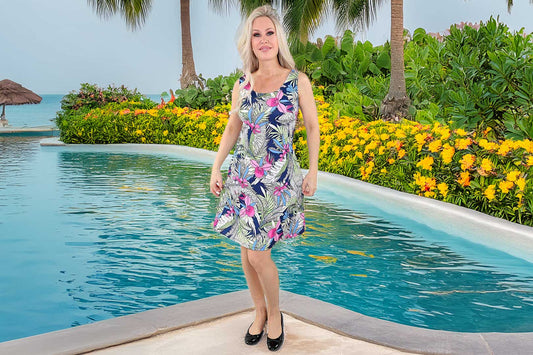
What Is the Difference Between a Sundress and a Summer Dress?
Share
When it comes to warm-weather fashion, the terms "sundress" and "summer dress" are often used interchangeably. However, these two dress styles have distinct characteristics that set them apart. While both are designed for hot weather, their design, purpose, and style differ significantly. This article delves into the core differences between sundresses and summer dresses, helping you understand which is more suitable for different occasions.
- What Is a Sundress?
- What-Is-a-Summer-Dress?
- Key Differences Between Sundresses and Summer Dresses
- Fabric Choices
- Design and Style
- Occasions and Use
- Which Dress Should You Choose?
- FAQs About Sundresses and Summer Dresses
What Is a Sundress?
A sundress is a casual, lightweight dress designed specifically for hot, sunny days. Typically made from breathable fabrics like cotton, linen, or rayon, sundresses are known for their comfortable and airy fit. These dresses often feature spaghetti straps, sleeveless designs, and flowing silhouettes, making them a go-to choice for picnics, beach outings, and casual gatherings.
Characteristics of Sundresses
- Fabric: Natural fibers like cotton or linen
- Design: Light, airy, and flowy
- Occasions: Casual, everyday wear
- Features: Sleeveless, spaghetti straps, often with floral or bright patterns
Why Are Sundresses Popular?
Sundresses have become a staple in summer wardrobes due to their versatility and comfort. Their simple yet stylish designs make them perfect for various casual activities without compromising on style.
What Is a Summer Dress?
A summer dress is a broader term encompassing any dress suitable for warm weather. Unlike sundresses, summer dresses can vary significantly in design, fabric, and purpose. These dresses range from casual daywear to elegant evening attire, depending on their cut and material.
Characteristics of Summer Dresses
- Fabric: Can include cotton, polyester, chiffon, and silk
- Design: Wide variety from casual to formal
- Occasions: Suitable for both casual and formal settings
- Features: Can have sleeves, different necklines, and varying lengths
Popular Types of Summer Dresses
- Maxi dresses
- Shift dresses
- Wrap dresses
- Cocktail dresses
Key Differences Between Sundresses and Summer Dresses
Understanding the differences between sundresses and summer dresses requires examining several factors, including fabric choices, design elements, and suitable occasions.
Fabric Choices
Sundresses:
- Made from breathable, natural materials like cotton, linen, and rayon
- Focus on lightweight fabrics to enhance airflow
Summer Dresses:
- Available in various materials, including silk, polyester, and chiffon
- Fabric choice depends on the style and occasion (casual vs. formal)
Design and Style
Sundresses:
- Simple, casual designs
- Sleeveless with thin straps
- Often adorned with floral prints and bright colors
Summer Dresses:
- Wide variety of styles (sleeveless, short sleeves, long sleeves)
- Can include more intricate details like lace, sequins, and embellishments
- Available in various lengths from mini to maxi
Occasions and Use
Sundresses:
- Best for casual, laid-back activities
- Ideal for beach days, picnics, and shopping trips
Summer Dresses:
- Suitable for both casual and formal events
- Can be worn at weddings, parties, and business-casual settings
Which Dress Should You Choose?
Choosing between a sundress and a summer dress depends on the occasion, personal style, and comfort preferences.
Choose a Sundress if:
- You’re attending a casual daytime event.
- You prioritize comfort and breathability.
- You want a light, easy-to-wear outfit for hot weather.
Choose a Summer Dress if:
- You need an outfit that can transition from day to night.
- You want more style options and fabric choices.
- You're dressing for a semi-formal or formal event.
Style Tips for Summer and Sundresses
- Accessories: Pair with sun hats, sunglasses, and light scarves for a chic look.
- Footwear: Sandals and espadrilles complement sundresses, while wedges or heels elevate summer dresses.
- Layering: Lightweight cardigans or denim jackets work well when the temperature drops.
FAQs About Sundresses and Summer Dresses
What Is the Main Difference Between a Sundress and a Summer Dress?
The primary difference is in the style and purpose. A sundress is specifically designed for casual, hot-weather wear with breathable fabrics and simple designs. A summer dress, however, is a broader category that includes sundresses but also encompasses more formal and versatile designs.
Can a Sundress Be Considered a Summer Dress?
Yes, a sundress falls under the summer dress category. However, not all summer dresses are sundresses due to the differences in style, material, and formality.
What Fabrics Are Best for Sundresses?
Cotton, linen, and rayon are the best choices for sundresses due to their breathable and lightweight nature.
Can I Wear a Summer Dress in Cooler Weather?
Yes. Many summer dresses can be paired with tights, boots, and jackets to transition into cooler seasons.
Which Dress Is More Comfortable in Extreme Heat?
Sundresses are typically more comfortable in extreme heat due to their lightweight fabric and breathable design.
While both sundresses and summer dresses are popular choices for warm-weather attire, understanding their differences helps you make informed fashion choices. Sundresses offer simplicity, comfort, and casual elegance, while summer dresses provide greater versatility and style options for various occasions. Whether you're heading to the beach or a summer wedding, selecting the right dress ensures you stay stylish and comfortable all season long.







